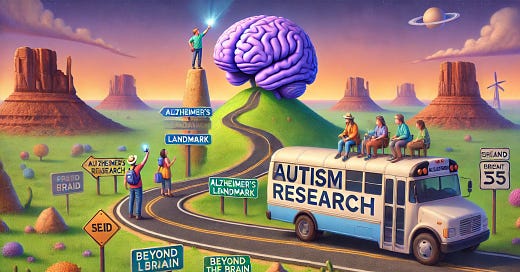The Itinerary
In several entries (perhaps more than several!) I’m going to take you on a journey through the last few years of my independent research into the etiology (i.e., underlying causes) of autism and Alzheimer’s disease. We’ll walk the trails and hear about some surreal theories on genes or maybe even catch a glimse of Mount Delusion. Key fact: Did you know that previous visitors on the trail had trouble finding Mount Delusion even though it’s enormous and current visitors never miss it, despite all of the mist at the top? Locals claim that Mount Delusion was only a wee mound just 50 years ago. However, most geologists think this a silly claim, rooted in superstition and mythology. Some have even attempted to climb to the peak, never able to actually reach it. Mount Delusion is the place where what was once invisible, is now impossible to miss!
We’ll then traverse deep into Metal Canyon and discuss some new things. Metal Canyon is a topsy-turvy place. Though we think we’re heading down, we’ll actually be climbing to quite a high altitude! It’s easy to get lost here but I think you’ll find it pretty interesting if you stay on the trail. Once we stop to stretch our legs and catch our breath, buy some postcards, and consider the evidence, we’ll hop back on the ride and come towards another brain disease landmark—Alzheimer’s.
There’s a warning sign up ahead! It says, “beyond this point heavy metals are banned.” You wonder, what might that mean and feel relief that you can still snap a picture. When we stop at Alzheimer’s Monument I’ll ask you to squint your eyes. I hope you’ll begin to notice the similarities to autism. Travelers from other parts of the globe may wonder why Alzheimer’s Monument is so large in comparison to similar monuments at home. Other vacationers wonder about the inscription on the bottom of the monument which bears the year in which it was built—early 20th century. After taking some selfies, and getting ourselves tangled up in plaques, we’ll board again and go off the beaten path, beyond the brain.
Will you come along?
What is this all about?
After several years attempting to go through the front door of science (read: publishing in journals), I’ve grown impatient and have come to the conclusion that perhaps I should start this substack to fully explain my research.
What are my bona fides?
Just a nonpracticing physician with a background in epidemiology who happens to take an interest in brain disorders and diseases. I’ve taken no funding in my work and hold no competing interests.
Subscriptions
If you want to be generous, dear reader, I take tips. Otherwise, this will be completely free.
Don’t forget to subscribe and share!




